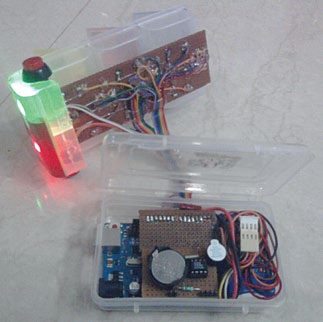System architecture
Swasthya Sanjivani has a three-tier architecture comprising:
Tier 1: Laptop. A laptop acts as the interface between the doctor and the Swasthya Sanjivani kit. Video conferencing connecting the doctor to the patient is achieved through Skype connection on the laptop.
Tier 2: Swasthya Sanjivani kit. This kit is supplied to operators in rural areas. The kit ensures that patients get an economical and on-the-spot blood and urine testing system at their doorstep.
Tier 3: Web portal (SkyDrive). The Web portal bridges the gap between rural and urban areas. The patient can be treated by a specialist doctor from a distant location.
How does it work?
The Swasthya Sanjivani kit works on the principle of colour-matching technique that has been widely used for urine and blood samples for years. The staff at rural centres can be technically trained to use the kit, take photographs and send these over to the expert centres where these samples could be diagnosed.
The kit consists of a test-tube stand, test tubes, camera, battery, motors and chain drive. A burette is positioned right above the test tube, with the help of an external stand.
After the blood or urine sample has been collected by the operator, he places the test tube with the sample in the test-tube stand. The sample moves towards the burette with the help of the motor and chain drive, and positions itself right under the tip of the burette with the help of sensors. With the help of the burette supported externally with a stand, the operator mixes the desired amount of a particular reagent in the sample. This initiates a chemical reaction in the test tube, which changes the colour of the sample.
Diseases like jaundice, diabetes and renal damage can be diagnosed by such colour-changing tests. The camera (attached on the left-hand side of the system) captures a picture of the chemically altered sample in the test tube and feeds it directly to the laptop.
The colour generator, when provided with RGB values, generates the colour of the sample. (Red, green and blue (RGB) are primary colours and any colour can be formed from the combination of these three colours.) This colour is communicated to the doctor by the operator and the doctor gives the feedback almost immediately to the patient.
Electronic pill box
The electronic pill box has small slots for distinct medicines. It is of great help to poor, illiterate people for three reasons: They can’t read the name of the medicine, they often overlook or neglect the medicines that they are supposed to take, and most of the medicines look the same to them.
[stextbox id=”info” caption=”Doctors’ take on Swasthya Sanjivani”]
“Swasthya Sanjivani is an innovative diagnostic test and alert system for diseases that can be really beneficial for peripheral areas.”
—Dr Nisha Marwa, professor, Department of Pathology, PGIMS, Rohtak
“Test results performed by the kit completely match lab results.”
—Khem Chand, senior lab technician, Department of Pathology, PGIMS, Rohtak
“Swasthya Sanjivani is a ground-breaking innovation that will open new research paradigms in the field of healthcare and prove to be a great help for people who are devoid of even the basic healthcare services.”
—Dr Suresh Arora, chairman, Surya Orthopedic Centre, Faridabad
[/stextbox]
This pill box helps patients to take the right drug, right dose at the right time. It connects to a PC/tablet via USB. The installed software permits the operator to easily customise the device to the patient’s medication regimen and dosage timing. The medication information stored in the memory of the pill box initiates an audio-visual signal to remind the patient about different medicine dosages and his next appointment scheduled with the doctor.
Components. The electronic pill box device is a portable embedded hardware device that incorporates a number of peripherals:
ATmega 328. Present on the Arduino Uno board, ATmega 328 microcontroller IC is used to program the electronic pill box. The Arduino board is connected to the computer via a USB port and can be programmed with the desired medication and appointment schedules through an app.
Real-time clock. DS1307 real-time clock is serially customised using I2C protocol. It is used for medicine scheduling and appointment by communicating with a Windows 8 application.

Reminder buzzer. It is used to alert the user about an appointment or time to take the medicine prescribed.
LEDs. SMD LEDs are used to guide the user on medicines and schedules as follows:
Medicines. LEDs placed below the compartment of the medicine blink at the scheduled time.
Scheduling. LEDs use innovative displays to indicate the various schedules that need to be followed.






